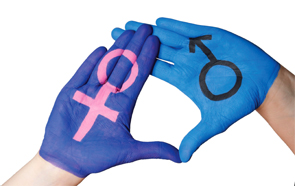
Image Credit: Nelosa/shutterstock.com
The lack of acknowledgment of this sexual dimorphism in pain is not surprising considering that pain in rheumatic diseases in general is an area that has not been examined closely enough, said Jon Levine, MD, PhD, professor of medicine in the Division of Rheumatology at the University of California San Francisco.
“We’ve made, in many ways, remarkably little progress,” he said. “I think we seriously have missed the boat in this particular area in the understanding of pain.”
Even though gender differences in pain mechanisms are less appreciated than they should be, it’s clear that women are more susceptible to certain rheumatic diseases than men: Systemic lupus erythematosus, systemic sclerosis, RA and others have a higher prevalence among women.
One factor in gender differences in pain and rheumatic diseases, Dr. Levine said, is the role that the extracellular matrix plays as an interface between the immune system and the nervous system. But a deep understanding of the mechanisms has been hindered by the approach to research: Almost all of the data that are available in understanding these mechanisms have come from animal and human studies involving exclusively male subjects, Dr. Levine said.
Because men and women both experience the same degree of magnitude of pain, and often for similar durations, the illusion exists that the mechanisms must be the same, he said.
But there are clear indications that important differences exist, he said.
How to Think about Pain
Dr. Levine said it makes sense to concentrate on the peripheral nervous system, both in looking at rheumatic disease pain and the gender differences of that pain. In particular, it’s important to recognize the relationship between what happens in the immune system and their peripheral mechanisms.
“Immune cells produce a large number of mediators that are able to act on a large number of receptors and able to produce sensitization to a number of different signaling pathways,” Dr. Levine said. That helps explain why pain can sometimes be so hard to treat, he said.
“It’s probably no wonder that individual signal blockers, individual mechanisms, have been relatively unsuccessful in terms of really maintaining chronic control of pain in patients where the disease over time may actually change in terms of its immune and biological function,” he said.
One factor in gender differences in pain & rheumatic diseases … is the role the extracellular matrix plays as an interface between the immune system & the nervous system.
It would help clinicians, he said, to alter the way in which they think about chronic pain—it’s not how long the pain lasts, but the mechanism of it. Thinking in terms of pain duration “gives us no insight into the biology of this pain,” and, therefore, no insight into how to treat it.
Chronic pain, he said, can come in two forms: one that can last for months or decades, but disappears when you remove the underlying cause; and another in which patients feel pain even when they’re in “remission,” with no sign of inflammation or disease, or when a patient becomes resistant to a kind of therapy that used to work.
Gender Differences
For all its limitations, research has produced some striking illustrations of gender pain mechanisms.
A key gender difference, Dr. Levine said, is in the mechanism underlying “hyperalgesic priming,” a process that leads to chronic pain. But the stimuli and pathways involved in this process vary greatly between men and women. For example, certain inflammatory stimuli—such as TNF-alpha and IL-6—initiate the process in men, but not in women.
In male rats, when male sex hormones are removed, the mechanisms involved in sensitization in the nociceptor are unchanged. In females, they are very different, with a protein kinase C-epsilon pathway that doesn’t exist in those in which the sex hormones are intact.
Studies of gender differences in the effectiveness of analgesics have been scant, but one study of the kappa-agonist, nalbuphine—led by Dr. Levine—shows a striking disparity. Women on a 10 mg dose of the drug had pain levels improve dramatically and continue to be improved; however, in men, the drug led to some relief at first, but ultimately resulted in worse pain levels than baseline.
Further study found that a mix of 5 mg of nalbuphine and 0.4 mg of naloxone led to pain relief that was similar in both men and women. This indicates that a completely separate receptor is at work in men, Dr. Levine said.
“There’s a second receptor that these drugs work in that makes pain worse,” he said. “Dramatically different between men and women.”
Dr. Levine expressed wonder that 5,000 years after opioids began to be used for pain relief, we only began to recognize gender differences about 20 years ago. Even now, he said, there is still an element of “it’s all in your head,” when it comes to women and pain, he said.
“Still, to this day,” he said, “I think that male patients are treated very differently from female patients.”
Thomas R. Collins is a medical writer based in Florida.

